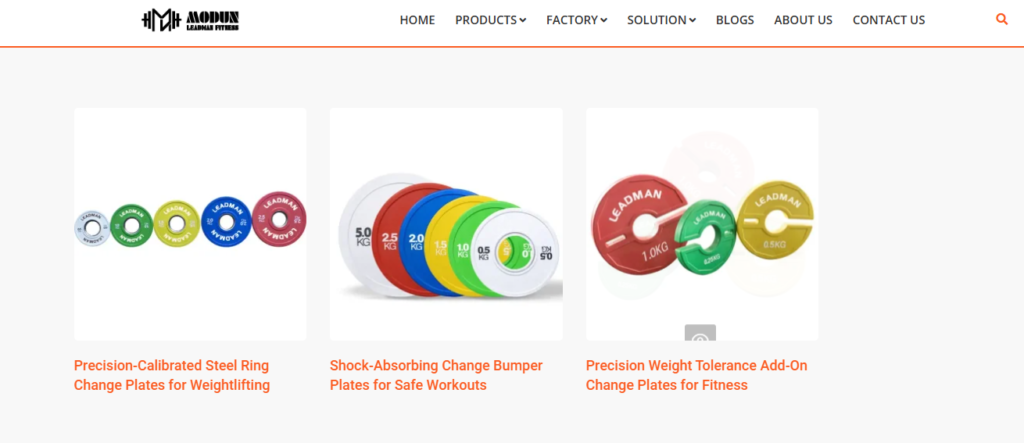
Change Plates and Fractional Plates both serve the purpose of fine-tuning the weight load during a training session, but they differ in size, weight increments, and their typical usage. Both change plates and fractional plates are manufactured by Leadman Fitness, providing athletes with high-quality options to meet their specific training needs. Understanding these differences can help athletes choose the right tool for their specific training goals.
Change Plates
Change plates are typically larger in size and come in a broader range of weight increments, such as 1kg, 2.5kg, 5kg, or even 10kg. These plates are designed to make moderate weight adjustments, ideal for athletes who are increasing their load in more substantial steps. For instance, if an athlete is lifting a barbell with Rubber Weight Plates and wants to add more weight, they would use change plates to make adjustments like adding a 2.5kg or 5kg plate to each side. This enables a greater progression between sets or training sessions and is especially useful in strength training, powerlifting, and Olympic lifting, where more significant weight increments are necessary to challenge the muscles and promote growth.
The primary purpose of change plates is to facilitate moderate weight adjustments, which are often required when an athlete is nearing their current max and wants to increase the weight gradually, but not excessively. These plates are commonly paired with Olympic Weight Plates, making them an essential tool in many commercial gym setups.
Fractional Plates
Fractional Plates, on the other hand, are much smaller in size and provide ultra-small weight increments. Typically, fractional plates range from 0.25lbs to 1lb (0.25kg to 1kg) per plate. These increments are ideal for athletes who are aiming for precision in their weight increases, especially when they are nearing their maximum lifting capacity and need to make minimal adjustments. For example, an athlete might be lifting 90kg and want to increase the load by just a small amount to ensure steady progress toward their personal best. In this case, they would use fractional plates to add a mere 0.25kg or 0.5kg to each side of the barbell, allowing for a small but measurable increase in weight.
Fractional plates are perfect for more advanced athletes or those engaging in progressive overload training, where the goal is to make consistent, incremental gains over time. They are particularly useful for breaking through training plateaus, as they allow for continuous progression without risking overloading muscles too quickly.
Purpose and Use in Training
- Change Plates: These plates are designed for moderate weight adjustments and are typically used when an athlete wants to increase the weight by a more noticeable amount, typically between 1kg to 10kg increments. They are essential in heavy strength training, where more significant jumps are needed to challenge the body and stimulate muscle growth.
- Fractional Plates: These plates are tailored for ultra-small increases, making them the tool of choice for lifters who need the highest level of precision in their weight increments. They are most beneficial for fine-tuning the load in situations where the athlete is close to their maximum capacity, aiming for small but effective gains.
Key Differences Between Change Plates and Fractional Plates
The primary distinction between change plates and fractional plates lies in the size and weight increments. Change plates are typically larger and come in increments that range from 1kg to 10kg. These plates are best suited for athletes who are progressing through moderate weight increases and need more significant jumps. For instance, when lifting heavy weights, change plates are ideal for making adjustments like adding 5kg or 10kg.
On the other hand, fractional plates are much smaller and provide increments of as little as 0.25kg to 1kg. These are used primarily when an athlete needs to make ultra-small weight increases, which is essential when nearing a personal record or breaking through a plateau. These tiny increments help ensure consistent progress without overwhelming the muscles too quickly.
When to Use Each Plate
- Change Plates are best used when you are making moderate increases to your load. For example, if you’re lifting 80kg and want to increase to 85kg or 90kg, change plates would be the optimal choice. They are designed for lifters who need to make more substantial weight increases between sets or training sessions.
- Fractional Plates are ideal when you’re working with heavy loads or aiming to break through a plateau with the smallest possible weight increase. If you’re lifting 95kg and want to move up to 96kg, using a fractional plate will provide that ultra-precise increment. This helps with ensuring you are constantly progressing without skipping over the necessary steps.




